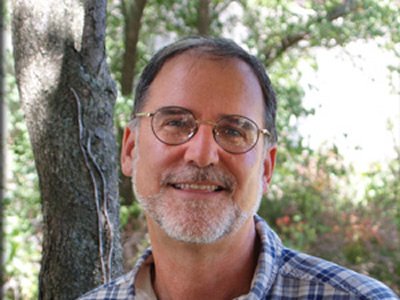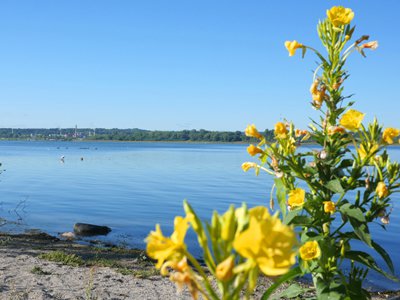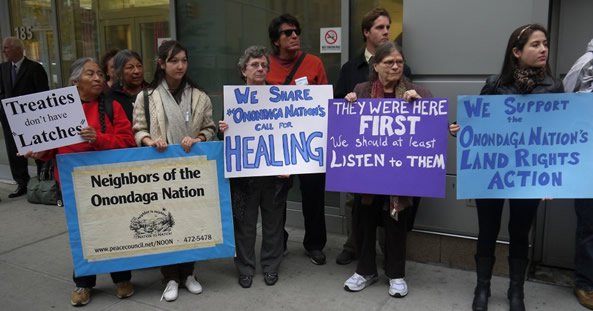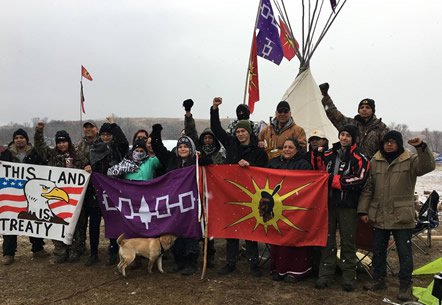Imagining Governance: A Q&A with Jack Manno G'03
Syracuse, ESF professor Jack Manno earned a Ph.D. in social science from Maxwell in 2003

Jack Manno G’03, professor of environmental studies at SUNY ESF and a faculty affiliate in Syracuse's Native American Studies program, believes in the power of change. Nowhere is it more sorely needed, he says, than in environmental policy, in which a growing number of crises are begging fresh approaches to organizational structure and governance. Manno believes part of the answer may lie in the past—specifically, in the Great Law of Peace, whose life-affirming principles of respect, reciprocity and renewal have guided Iroquoian political thought for more than 1,000 years.
“There’s considerable evidence that the Iroquois Confederacy influenced the framers of the U.S. Constitution,” says Manno, during a recent phone conversation from his office in Marshall Hall on the ESF campus. “Some of the framers, notably Thomas Jefferson and Benjamin Franklin, admired the concepts of the Six Nations [of the Iroquois Confederacy], so aspects of their political system eventually were incorporated into the Constitution itself.”
Manno contends that, as a new political regime gets underway in the United States, the need for an effective governance system—one in step with climate change and the environment—is imperative. “Standing Rock taught us a lot about the importance of tribal sovereignty, water and the environment,” he continues. “It also showed us the darker side of the struggle for energy independence.”
In a recent article in Minding Nature (Center for Humans & Nature), Manno expounds on governance’s role in saving the planet. He points to the Great Law of Peace—the Iroquois Confederacy’s oral constitution, founded at Onondaga Lake, north of the City of Syracuse—as a prime example of participatory governance rooted in ecological and human well-being.
The College of Arts and Sciences recently caught up with Manno, who also is involved with The Skä•noñh—Great Law of Peace Center and the Program for the Advancement of Research on Conflict and Collaboration in the Maxwell School (from which he earned a Ph.D. in social science), to discuss a new model for environmental governance.

You have written a lot about the Indigenous perspective in environmental governance. Would you expand on it?
The Indigenous perspective has been a significant factor in the ongoing battle over unconventional gas drilling in our country. History has shown that when native and non-native people work together, good things can happen. New York’s ban on hydro-fracking, which went into effect in 2015, is a prime example.
Some of my research involves native and non-native alliances. As non-native people begin to encounter a native worldview, we see a big difference in the two legal systems. The best way to explain it is by contrasting the Haudenosaunee’s responsibility-based approach to law with our rights-based approach … at the local, state and federal levels. [The Haudenosaunee, or “People of the Longhouse,” refers to the Six Nations: the Mohawk, Seneca, Oneida, Onondaga, Cayuga and Tuscarora tribes.] When our system looks at land and water, and other so-called natural resources, the first questions are “Who are the owners?” and “What rights do they have?” By contrast, the native approach is to find out who the keepers are—the people responsible for the place’s well-being.
Can both approaches co-exist?
Rights and responsibilities are complimentary ways of understanding relations between people and the environment. Our system is overwhelmingly concerned with rights, with responsibilities often left to the owners’ discretions. This is one example of how we can learn from and honor Indigenous perspectives, when making environmental and ecological decisions.
Our best chance is to work through the U.S. EPA [United States Environmental Protection Agency], which protects our land, water and air. There are many people, however, who claim their economic rights trump the EPA’s responsibilities. Recent actions by the new administration to freeze EPA projects and funding are intended to reduce the authority of those who claim and legally have responsibility for caring for the environment.

How does the Indigenous perspective fit into our modern-day governance system?
For a governance system to rule, it requires brute force or democratic legitimacy. The latter is preferred, and should be built by a citizenry who understand how their fate depends on the success of their government and vice versa. At the core of [democratic legitimacy] is interdependence—right action and behavior that advances both the welfare of the individual and of the group, as a whole.
The Great Law of Peace is probably the best example we have of an environmentally responsible, democratically legitimate government. Founded in Central New York, it marked the culmination of a long, drawn out conflict-resolution saga. The confederacy endures to this day, despite unchecked colonialism and hundreds of years of attempted cultural and physical genocide. It's one of the world’s longest-functioning democratic institutions.
I should add that the Great Law of Peace is rooted in social and political social bonds that exist among its six independent nations, as well as a shared respect for the laws of nature.
What does the Great Law of Peace espouse?
Gratitude, healing, shared power between men and women, a respect for traditional and native peoples’ rights and responsibilities. Sovereignty and clan identity are also important, and help foster mutual respect, equity and empowerment.
I suppose any discussion about governance systems and U.S. Indian law, in particular, involves the Doctrine of Discovery.
Right. The doctrine is rooted in 15th-century imperialism—that you can go anywhere you want and take whatever you want from non-Christian people. From it sprung a long debate, involving the pope [Alexander VI], over whom was considered human and whom was not, and whether or not native people had a soul. If they had a soul, you couldn’t just kill them, but you could “Christianize” them.
Do you think the [Catholic] Church will repudiate the doctrine?
A few churches have, but, even if the Catholic Church does rescind it, I don’t know if it would make a real difference or not, other than just being a great symbolic victory. It wouldn’t affect any laws, really.
[The Doctrine of Discovery, also known as Manifest Destiny, was quietly written into U.S. law in 1823 as a way to deny land rights to native peoples. The law has yet to be repealed.]
The doctrine was cited as recently as 2005, with the U.S. Supreme Court’s decision in the City of Sherrill v. Oneida Nation of New York, justifying the taking of Indigenous lands.

One of many land-claim dismissals in the area.
Another was the Onondaga Nation Land Rights Action. It was denied a hearing in U.S. federal court in 2013 because the court claimed the actions would disrupt the local community, and that too much time has passed since the land had been taken away. [The Nation argued that New York State, Onondaga County and the City of Syracuse had illegally seized approximately 4,000 square miles in 11 counties, over the decades, through a series of bogus treaties.]
The court also ignored many of the efforts undertaken by organizations such as the Neighbors of Onondaga Nation and by area colleges and universities, including Syracuse and ESF, to educate people about some of the issues raised by the Onondaga Nation. There has been considerable evidence that the Onondaga Nation Land Rights Action, instead of being disruptive, actually brought people from these distinct cultures closer than ever.
More recently, some of the same people have supported the Standing Rock “water protectors,” taking native and non-native solidarity to a new level. Symbolism matters to the native people. That’s why they call themselves “water protectors,” instead of “water protesters.”

Clearly, natives and non-natives view the world differently.
They see humans and the natural world differently. Between our way of understanding the world and native people’s way of seeing it, there is a gap between rights and responsibilities, as mentioned earlier. At Standing Rock, the “protectors” felt they had a responsibility to protect the water. [The oil company] felt they had a responsibility to protect the pipeline … because they owned it.
We’ve come a long way from the 1490s, when the Doctrine of Discovery was created. Back then, people hardly had any rights—free speech, property, redress for harms.
The kings and queens of Europe didn’t allow anybody to own anything. So when the Europeans came over here, it was such a big deal [to own land] that they were willing to fight and die for it. Now this fight is destroying the Earth.
We must switch our dependence on fossil fuels to something else. Native people understand, probably more so than anybody else, that water is life. If there’s any kind of leak or rupture in an oil pipeline, water gets contaminated.
Which may explain why traditional ecological knowledge, or TEK, is fast-growing on college campuses.
At ESF, we have a policy that, whenever new people—parents, new or prospective students—come to campus, they are made to feel welcomed. They are told they’re standing on Onondaga land.
It’s important to revitalize indigenous knowledge and values. A big one is to treat Onondaga Lake as a sacred lake. Some of us are considering an effort to get UNESCO [the United Nations Educational, Scientific and Cultural Organization] to designate it as a World Heritage Site.
Whenever we make a decision about Onondaga Lake, we need to ask the Native people about it, first. We should be looking at the lake through their lens, respecting their vision for it. This vision is reflected in the Thanksgiving Address, a prayer and invocation for the Haudenosaunee that teaches respect and love for the natural world.
What else should we do?
Educate ourselves. Get involved. They’re the best ways to bring about a change of heart and a change of mind.
